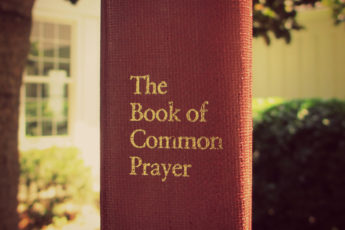Living in beautiful time: an introduction to the Christian Year

Time is a creation of humans. I don’t mean the actual “thing” of time (which some scientists aren’t quite sure is a real thing anyway, more like the perceived consequences of other real things). I’m speaking of what we think of whenever we think about what time or what day it is, what we mean when we say it’s one o’clock in the afternoon or Tuesday or the end of the week. All of this is an invention of human culture.
And as culture changes, so does our perception time’s passing. In the modern West, we retain remnants of our spiritual heritage’s ordering of time, seen most prominently in the celebration of Christmas. But most of the other significant dates on our calendar have little to do with spirituality: Thanksgiving, New Year’s Day, Valentine’s Day, Tax Day, Labor Day, the beginning and ending of the school year, and many others. We order our lives by the work week and too-short weekends, monthly paychecks, by fiscal quarters and the next shopping holiday. Our calendars have become flat and colorless and so has our perception of time.
It was not always this way. The ancient church took seriously the call to discipleship, using every means at their disposal to order their lives more deeply with the life and teachings of Jesus. The reckoning of days, weeks, months, and years became a canvas upon which to paint the life of Christ so that they could live these events in a way that went beyond merely reading or thinking about them. The life of Jesus became for them a gentle, colorful pattern of celebration and reflection that with each repetition, deepened the faith of those who lived it. They saw themselves as living out the story of Jesus in their own lives, learning to live as he lived.
The discipline of ordering time this way is called simply the Christian Year or the Christian Calendar. It is an ancient way of ordering time according to the major events of Jesus’ life: his birth, baptism, death, burial, and resurrection, ascension, and the coming of the Holy Spirit upon the church. Each of these events has momentous shaping power for the apprentice who seeks to live life like Jesus, formed by his heart and his priorities, loving as he loved and fulfilling the will of God in the world.
The discipline of living within the rhythms of the Christian Year has proven its utility teaching and shaping of Christians for literally thousands of years. Virtually all denominations are recovering some form of observance of the Christian Year, so you’ll see Advent wreaths, Christmas Eve vigils, and Good Friday services in Baptist churches and churches of Christ, all of which would have been unheard of even thirty years ago.
Why is this? What is so powerful about the observance of the Christian Year?
The first reason is that it allows for sustained attention on the most important teachings in the life of Jesus. The events of Jesus’ life are rich with meaning, teaching us important truths about the nature of God, creation, humanity, and life itself. We see in Jesus’ birth the fulfillment of promises going back hundreds of years, culminating in the profound implications of God himself putting on flesh and entering the sinful world in order to save it. We see in the cross the God’s answer to our sin and the heart of God in the face of a world turned against him. We see in his resurrection the final destruction of corruption and death, as well as the glorious life to come for all who follow Jesus. This is to say nothing of the rest of his earthly ministry, his Ascension, of the coming of the Holy Spirit on the church, and so much more. The seasons of the Christian year set aside periods of time for the church to give sustained attention to these teachings, encouraging apprentices of Jesus to go deeper into these mysteries and their attendant transformative practices with each passing year.
The second reason is that the observance of the Christian Year takes us deeper than merely cognitive or intellectual teaching can. We live these events ourselves in feasts and celebrations, in the singing of songs specific to the occasion, in the adorning of our churches and our homes with art that carries the beauty and truth of Jesus and his life into our hearts. By living these rhythms and surrounding ourselves with meaningful signs that point to these realities, we aren’t merely sitting in a classroom comprehending facts, we are learning to live a certain kind of life.
The third reason is that ordering our time this way shapes not just a person but a people—with a shared perception of time and its significance. We do this together, experiencing the joy and mystery of these events through the eyes of our children and families, our friends and fellow pilgrims looking for the same good life Jesus offers. The life of Jesus was passed on to a people and these people live out his mission in the world. Marking time this way reinforces the identity of God’s people, giving them a firm and vivid pathway to walk together through the confusion that results from the aimlessness of the self-absorbed modern life.
The fourth reason is that living by the rhythm of the Christian Year puts all other times and events in their proper perspective. No matter what else is happening, it is happening within the realm of God’s gracious care and his providential guidance. Great and wonderful (or terrible) events may happen, but no moment is ever beyond the reach of his redemptive power. Nothing can or will happen that will be of greater power or truth than the truth that God is with us. The “now” belongs to God and so does the future, secure and perfect, kept in heaven to be revealed at its proper time.
Interested in knowing more? Here’s a brief overview of the seasons of the Christian Year and how each of them help us to draw near to God’s transforming intent for our lives.









Leave a Comment